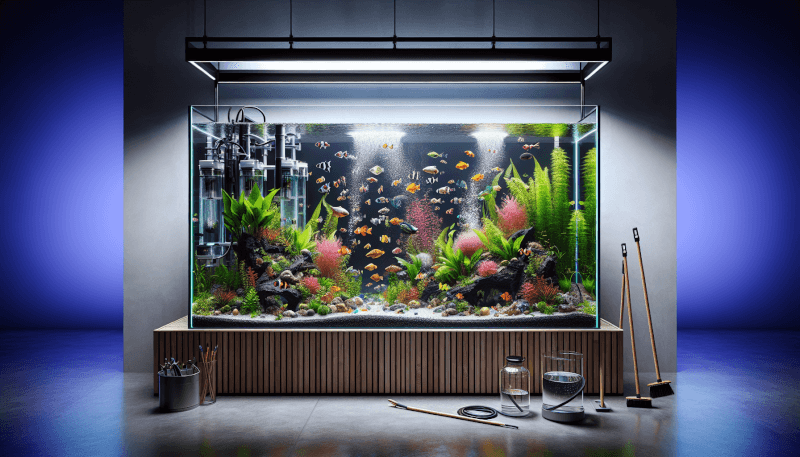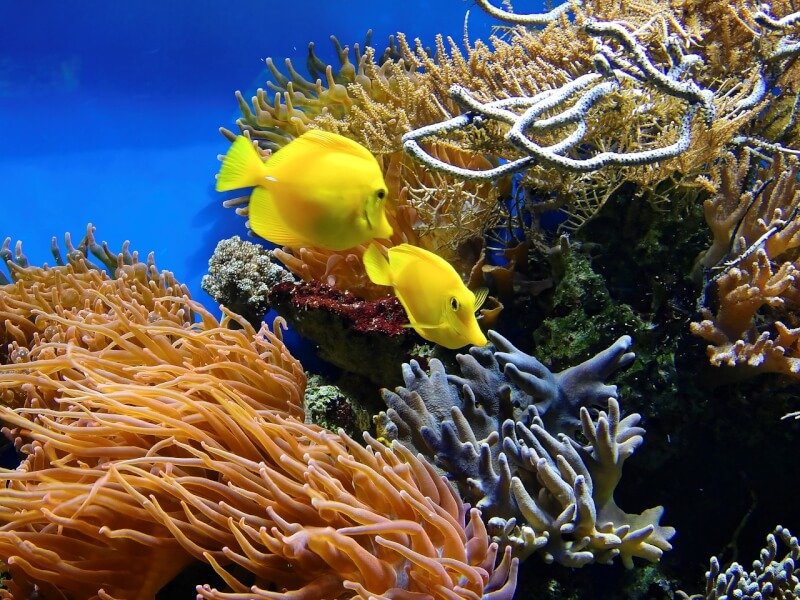Maintaining a clean and beautiful aquarium may seem like a daunting task, but with a few simple steps, you can ensure that your aquatic environment remains healthy and thriving. From regular water changes to proper cleaning techniques, this article will provide you with all the essential tips and tricks to keep your aquarium looking its best. So, grab your fishnet and get ready to dive into the world of aquarium maintenance!
Cleaning and Maintaining the Aquarium
Keeping your aquarium clean and well-maintained is essential for the health and wellbeing of your fish. Proper cleaning and maintenance also contribute to creating a visually appealing and beautiful aquarium that you can enjoy. In this section, we will discuss various aspects of cleaning and maintaining your aquarium to ensure a clean and pristine environment for your fish.
Testing the Water Quality
Regularly testing the water quality in your aquarium is crucial for maintaining a healthy ecosystem for your fish. Test kits are readily available and allow you to assess parameters such as pH, ammonia levels, nitrite levels, and nitrate levels. Monitoring these levels helps you detect any imbalances and take necessary actions to correct them. Remember that different fish species have specific water parameter requirements, so it’s important to know the ideal conditions for your fish and adjust accordingly.
Performing Regular Water Changes
One of the most important tasks in maintaining aquarium cleanliness is performing regular water changes. Over time, waste and pollutants accumulate in the water, affecting the water quality and potentially harming your fish. By replacing a portion of the water on a weekly basis, you can remove the accumulated waste and restore the water quality. Aim to replace approximately 10-15% of the water each time, ensuring that the replacement water is at the same temperature and properly treated with a water conditioner to remove harmful chlorine and chloramines.
Cleaning the Gravel
The gravel in your aquarium not only provides a decorative touch but also acts as a biological filter, hosting beneficial bacteria that aid in the breakdown of waste. However, debris can accumulate in the gravel, compromising its effectiveness and making it visually unappealing. To clean the gravel, use a gravel vacuum or siphon, gently stirring the gravel while removing any debris and excess food. Aim to clean a small section each time you perform a water change to prevent disturbing the entire tank at once.
Cleaning the Glass
Maintaining clean glass not only enhances the visual appeal of your aquarium but also allows for better visibility of your fish and the overall environment. Cleaning the glass regularly involves gently scrubbing away any algae or mineral deposits using an aquarium-safe glass cleaner or a soft sponge. Avoid using abrasive materials that may scratch the glass. Additionally, consider using an algae scraper or magnetic scraper for those hard-to-reach areas.
Maintaining Proper Filtration
A well-functioning filtration system is essential for maintaining water clarity and removing harmful substances from your aquarium. Regularly check the filter for debris and clean or replace filter media as needed. It’s important to follow the manufacturer’s guidelines for maintaining your specific filtration system, ensuring optimal performance. Remember that removing all filter media at once can harm beneficial bacteria, so stagger the cleaning or replacement.
Maintaining the Right Temperature
Maintaining a stable and appropriate temperature is vital for the health and wellbeing of your fish. Use a reliable aquarium heater and thermometer to monitor and regulate the water temperature. Aim to keep the temperature consistent within the recommended range for your specific fish species. Sudden fluctuations in temperature can stress or even harm your fish, so take precautions to prevent rapid temperature changes.
Checking and Maintaining Equipment
Regularly inspecting and maintaining the equipment in your aquarium is crucial for its proper functioning. Check the condition of all equipment, such as pumps, heaters, filters, and lighting fixtures. Replace any worn-out or malfunctioning parts promptly. Additionally, ensure that all electrical connections are secure and that no exposed wires pose a safety hazard. Regular maintenance and inspection help prevent equipment failures and maintain a safe environment for your fish.
Maintaining a Healthy Environment for the Fish
Creating and maintaining a healthy environment for your fish goes beyond just physical cleanliness. Providing appropriate living conditions and attending to their behavioral and nutritional needs are equally important aspects of fishkeeping. In this section, we will discuss measures you can take to ensure the well-being and happiness of your fish.
Choosing the Right Fish for Your Aquarium
When selecting fish for your aquarium, it’s essential to consider their compatibility, temperament, and specialized care requirements. Research different fish species to determine their water parameter needs, tank size requirements, and social behavior. Avoid combining aggressive and peaceful fish in the same tank, as it can lead to stress and potential harm. Carefully choose fish that will thrive in your aquarium’s conditions, promoting harmony and reducing the risk of conflicts.
Providing Proper Nutrition
Feeding your fish a balanced and appropriate diet is vital for their overall health and vitality. Most fish species require a combination of dry, frozen, and live foods to meet their nutritional needs. Feed your fish small amounts a couple of times a day, ensuring that they consume the food within a few minutes. Overfeeding can lead to water pollution and obesity, while underfeeding can result in malnutrition. Observe your fish to determine their eating habits and adjust the amount and type of food accordingly.
Avoiding Overcrowding
Maintaining an appropriate fish population in your aquarium is crucial for their well-being. Overcrowding can lead to increased competition for resources, stress, and the spread of diseases. Research the adult size and territorial requirements of each fish species you intend to keep and ensure that your tank is adequately sized to accommodate them comfortably. Follow recommended guidelines for the number and size of fish based on your aquarium’s volume.
Monitoring Fish Behavior and Health
Regularly observing your fish and monitoring their behavior and health can help you detect any signs of stress, illness, or aggression. Look for changes in eating habits, swimming patterns, coloration, or physical abnormalities. Unusual behavior or sudden changes may indicate underlying issues that require attention. Promptly address any concerns by consulting with a knowledgeable aquatic veterinarian or specialist to ensure the well-being of your fish.
Managing Algae Growth
Algae growth is a common challenge in aquarium keeping, but it can be managed effectively. Algae growth is usually a result of excessive light, nutrients, or fluctuations in water parameters. Ensure a consistent lighting schedule and duration appropriate for your aquarium and adjust as necessary. Avoid overfeeding and perform regular water changes to control nutrient levels. Additionally, consider adding algae-eating fish or introducing natural algae controls, such as snails or shrimp, to help keep algae growth in check.
Creating and Sustaining a Beautiful Aquarium
Beyond the necessary cleaning and maintenance, creating a beautiful aquarium is a chance to showcase your creativity and create a visually stunning underwater world. In this section, we will explore various aspects of designing and maintaining an aesthetically pleasing aquarium.
Choosing the Right Decorations and Plants
Selecting appropriate decorations and plants is crucial for establishing an attractive and harmonious environment in your aquarium. Consider the natural habitats of your fish species and choose decorations that mimic their natural surroundings. Driftwood, rocks, and caves can provide hiding spots and add visual interest. For planted aquariums, choose aquatic plants that are compatible with your fish, lighting setup, and water parameters.
Arranging Decorations and Plants
The arrangement of decorations and plants in your aquarium is an opportunity to create a visually appealing and balanced composition. Place taller plants or decorations towards the back of the tank and gradually arrange shorter ones towards the front. This creates depth and perspective, enhancing the overall visual impact. Leave open swimming spaces for your fish, allowing them to move freely and enjoy their habitat.
Proper Lighting for Aquarium
Choosing the right lighting for your aquarium is crucial for the health and growth of your fish and plants, as well as the overall aesthetics. Determine the lighting requirements of your fish and plants, considering the intensity and spectrum of light they need. LED lighting is becoming increasingly popular due to its energy efficiency and customizable features. Establish a lighting schedule that replicates natural day and night cycles, providing adequate periods of light and darkness.
Maintaining a Balanced Water Chemistry
Maintaining a balanced water chemistry is essential for both the health of your fish and the vibrancy of your aquarium. Regularly test the water parameters, including pH, hardness, and nutrient levels, and make necessary adjustments. Many fish and plants thrive in slightly acidic to neutral pH ranges, while others may have specific requirements. Monitor the water quality closely, especially when introducing new fish or plants, to ensure their success and maintain the beauty of your aquarium.
Preventing and Treating Common Fish Diseases
Despite our best efforts, fish diseases may occur in any aquarium. Understanding common fish diseases, their causes, and symptoms is essential. Regularly inspect your fish for any signs of illness or abnormal behavior. Quarantine new fish before introducing them to the main tank to prevent potential disease outbreaks. If you notice any signs of disease, promptly identify and treat the issue according to the specific disease and the recommendations of a knowledgeable aquatic veterinarian.

Planning and Organizing Your Maintenance Schedule
Maintaining a clean and beautiful aquarium requires proper planning and organization. Establishing a regular maintenance routine can help you stay on top of tasks and prevent any issues from becoming overwhelming. In this section, we will explore some tips on planning and organizing your maintenance schedule effectively.
Creating a Checklist
Start by creating a checklist of tasks that need to be done regularly to maintain your aquarium. This can include items such as water changes, filter maintenance, equipment checks, and feeding schedules. Having a visual reminder of what needs to be done can help you stay organized and ensure that no crucial steps are missed.
Establishing a Routine
Once you have your checklist, establish a routine that works best for you and your aquarium. Consistency is key, so try to set a specific day or time each week dedicated to maintaining your aquarium. This routine will help you perform tasks regularly and prevent any build-up of waste or neglected equipment.
Recording and Analyzing Data
Keeping records of your aquarium’s parameters, maintenance tasks, and any observations you make can be incredibly helpful in identifying patterns or changes over time. Create a system for recording data, either through a digital spreadsheet or a dedicated notebook. This record can serve as a reference point and assist you in troubleshooting any issues that may arise.
Seeking Professional Advice
If you encounter any difficulties or have concerns about your aquarium, don’t hesitate to seek professional advice. Many local fish stores have knowledgeable staff who can provide guidance on specific issues. Additionally, consult with aquatic veterinarians or specialized forums and communities online. Remember, it’s better to address concerns early on rather than allowing them to escalate and potentially harm your fish.
In conclusion, maintaining a clean and beautiful aquarium requires regular attention, dedication, and careful planning. By implementing proper cleaning and maintenance practices, creating a healthy environment for your fish, and designing a visually appealing aquarium, you can enjoy a thriving aquatic ecosystem that brings joy and tranquility to your home. Remember to establish a maintenance schedule, monitor your fish’s behavior and health closely, and seek professional advice when needed. With these guidelines in mind, you can create the aquarium of your dreams and provide a safe and beautiful home for your fish.



